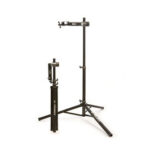For riders eager to find the best lightweight electric dirt bike without breaking the bank, the current market offers a compelling range of options under $5,000. To cut through the noise and provide definitive answers, we at usabikers.net put eight of the most talked-about lightweight eMotos through rigorous testing. Our goal was simple: to identify the pros and cons of each bike and ultimately crown the best in class.
Our testing team brought diverse riding experience to the table. Dustin, a seasoned double A class enduro racer, provided expert insights into performance and handling. Michael, a B class racer, offered a perspective grounded in competitive riding. Mike, with his background in downhill mountain bike racing, assessed agility and suspension capabilities. And Tucker, our founder, ensured the tests reflected the needs of everyday riders. Together, we subjected each bike to a series of evaluations across varied terrains, ranking them based on a comprehensive set of criteria. Here’s a detailed look at our findings.
Meet the Contenders: 2024 Lightweight Electric Dirt Bikes
Our test lineup included these popular models:
- Beta Explorer
- Surron Lightbee X
- Talaria Sting R
- Rawrr Mantis
- E Ride Pro SS 2.0
- Stage 2 M1
- RFN Ares DLX Version 2.0
- 79Bike Falcon M
Each bike was meticulously assessed in categories crucial for off-road performance: peak power, acceleration in drag races, real-world battery range, ease of battery swapping, braking performance, weight, suspension quality, and of course, price.
Power Play: Ranking Peak Power
When it comes to raw power, the RFN Ares DLX and Beta Explorer stood shoulder to shoulder at the top, both delivering an impressive 12.5kW peak power. Hot on their heels was the E Ride Pro SS 2.0, boasting 12kW peak and 5kW nominal power. At the other end of the spectrum, the Surron Lightbee X and Stage 2 M1 shared the last spot with 6kW peak and 3kW nominal power.
It’s crucial to note that several bikes – the E Ride Pro SS, Beta Explorer, and RFN Ares DLX – are equipped with a turbo or “rocket” mode. This feature provides a temporary surge of power, significantly boosting peak output for bursts of acceleration or tackling challenging obstacles. Therefore, riders should consider both nominal and peak power figures to understand the bike’s overall power delivery characteristics.
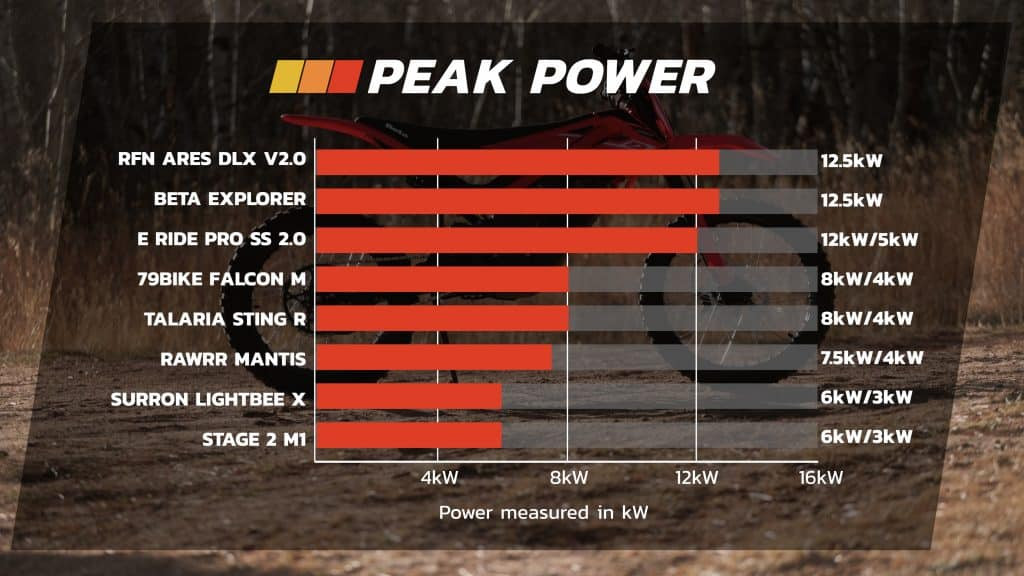 A visual comparison of the 2024 electric dirt bikes and their peak power output, highlighting the RFN Ares DLX and Beta Explorer at the top.
A visual comparison of the 2024 electric dirt bikes and their peak power output, highlighting the RFN Ares DLX and Beta Explorer at the top.
Drag Race Domination: Acceleration and Top Speed
Our first real-world test was a drag race, designed to evaluate each bike’s acceleration and top speed prowess. We began with an initial group comprising the Beta Explorer, Surron Lightbee X, Talaria Sting R, and Rawrr Mantis. In this first heat, the Talaria Sting R immediately demonstrated its superior acceleration.
We then pitted the Talaria Sting R against the RFN Ares DLX, E Ride Pro SS, and Stage 2 M1. The E Ride Pro SS quickly emerged as the bike to beat, showcasing blistering acceleration and top speed. Finally, with the arrival of the 79Bike Falcon M, we challenged it against the Talaria Sting R, the previous second-fastest bike. The Falcon M swiftly claimed the second spot, but the E Ride Pro SS remained unchallenged as the undisputed champion in acceleration and top speed within this lightweight electric dirt bike category.
 Electric dirt bike drag race in 2024: E Ride Pro SS takes the lead against Talaria Sting R and 79Bike Falcon M, showcasing top acceleration.
Electric dirt bike drag race in 2024: E Ride Pro SS takes the lead against Talaria Sting R and 79Bike Falcon M, showcasing top acceleration.
Battery Endurance: Range and Capacity Tested
Battery range is a critical factor for any electric dirt bike. To determine real-world range, we rode each bike until its battery level reached approximately 15 percent. In terms of battery capacity, the RFN Ares Rally DLX led the pack with a substantial 3.2kWh, followed by the E Ride Pro SS with 2.9kWh.
However, battery capacity doesn’t always directly translate to range. In our range testing, the E Ride Pro SS delivered the longest range at 25 miles per charge. The 79Bike Falcon M was a close second with 24 miles, and the RFN Ares DLX achieved 23 miles. The Talaria Sting R managed 19 miles, the Surron Lightbee X 17 miles, the Beta Explorer 15 miles, the Rawrr Mantis 14 miles, and the Stage 2 M1 trailed with 11 miles.
 Battery range comparison of 2024 electric dirt bikes, highlighting E Ride Pro SS, 79Bike Falcon M, and RFN Ares DLX as top performers.
Battery range comparison of 2024 electric dirt bikes, highlighting E Ride Pro SS, 79Bike Falcon M, and RFN Ares DLX as top performers.
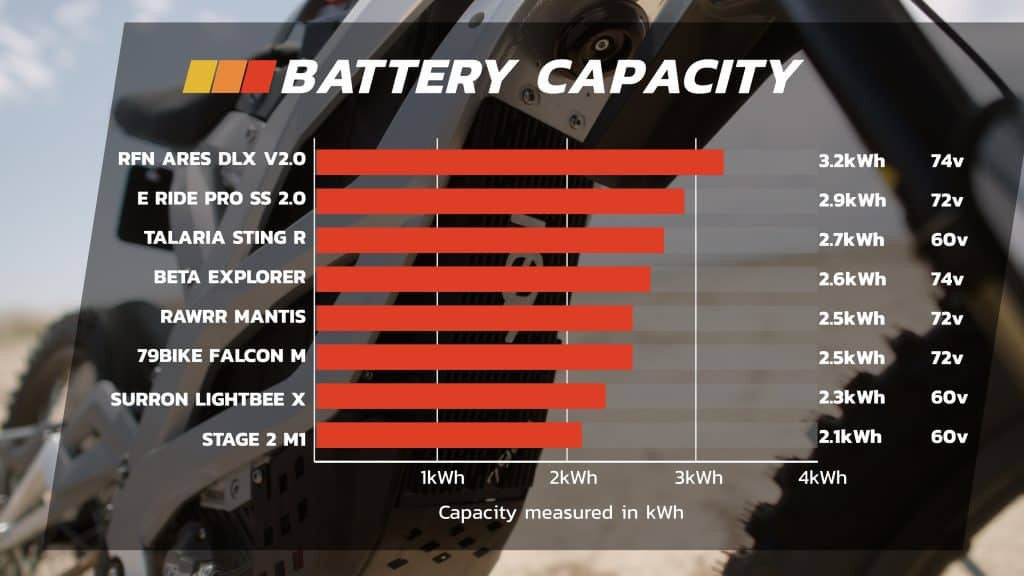 Battery capacity chart for 2024 electric dirt bikes, showing RFN Ares Rally DLX leading with 3.2kWh followed by E Ride Pro SS.
Battery capacity chart for 2024 electric dirt bikes, showing RFN Ares Rally DLX leading with 3.2kWh followed by E Ride Pro SS.
Battery Swap Convenience: Ease of Removal
For riders planning extended rides or needing quick turnarounds, battery swapping is a valuable feature. We ranked the bikes based on the speed and ease of battery removal, from most convenient to least.
 Ranking the ease of battery swapping on 2024 electric dirt bikes, with Surron Lightbee X and Talaria Sting R leading in convenience.
Ranking the ease of battery swapping on 2024 electric dirt bikes, with Surron Lightbee X and Talaria Sting R leading in convenience.
The Surron Lightbee X, Talaria Sting R, E Ride Pro SS, and 79Bike Falcon M all share a very similar battery compartment design. While the compartment style is alike, battery sizes and compartment tolerances vary, leading to differing levels of removal ease. The 79Bike Falcon M, despite the similar design, proved to be the most challenging in this group due to its larger battery fitting tightly within a compact compartment.
The Surron Lightbee X emerged as the easiest for battery removal within this group, followed by the Talaria Sting R and E Ride Pro SS. However, a trade-off with easier removal was a tendency for battery rattle. Riders of these models may need to shim the battery compartment to minimize movement and noise.
The Rawrr Mantis features an automatic button for battery release, making swaps incredibly easy. However, this system is non-functional when the battery is fully disconnected, which is a notable drawback.
The Stage 2 M1, RFN Ares DLX, and Beta Explorer all presented more complex battery removal processes. The Stage 2 M1’s full-size seat hinders quick swaps. The RFN Ares DLX and Beta Explorer share an identical, intricate design, making battery changes slower. Given the RFN Ares DLX’s heavier battery, the Beta Explorer earned a slight edge for marginally easier removal within this category.
Braking Power: Stopping Performance
Effective brakes are paramount for safety and control, especially in off-road riding. The 79Bike Falcon M stood out with exceptional braking performance. Its stock brakes are by far the most powerful we’ve encountered on any eMoto in this class. The E Ride Pro SS secured a solid second place in braking. The Rawrr Mantis, unfortunately, lagged significantly behind, placing last in this critical category.
 Comparing braking performance of 2024 electric dirt bikes, highlighting 79Bike Falcon M as having the best brakes in the test group.
Comparing braking performance of 2024 electric dirt bikes, highlighting 79Bike Falcon M as having the best brakes in the test group.
Weight Matters: Handling and Agility
Weight significantly impacts a dirt bike’s handling and agility. The Surron Lightbee X was the lightest bike in our test, tipping the scales at a mere 123 pounds. The Rawrr Mantis was the heaviest at 165 pounds. The 79Bike Falcon M struck a good balance, remaining relatively lightweight at 130 pounds despite housing a larger 72V battery.
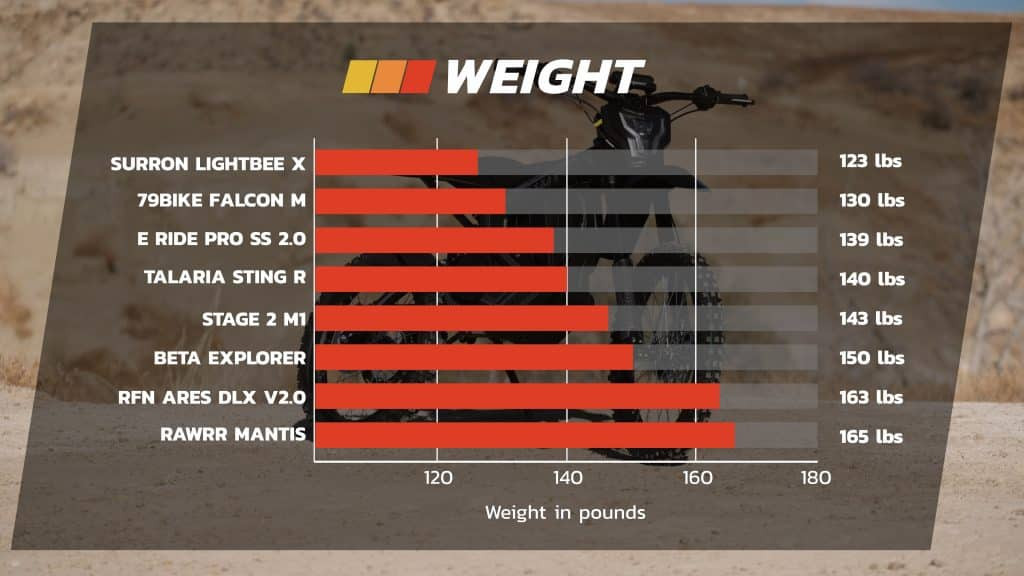 Weight comparison of 2024 electric dirt bikes, showing Surron Lightbee X as the lightest and Rawrr Mantis as the heaviest model.
Weight comparison of 2024 electric dirt bikes, showing Surron Lightbee X as the lightest and Rawrr Mantis as the heaviest model.
Suspension Prowess: Ride Comfort and Control
Suspension is key to off-road comfort, control, and performance. The Talaria Sting R boasted the best suspension setup in our test. Our test bike was equipped with a FastAce fork and shock, and some Sting R models even come with the Talaria Factory fork, representing the best factory suspension we’ve experienced in this class.
The Surron Lightbee X surprised us with its runner-up suspension performance. While earlier Surron models sometimes suffered from inconsistent suspension, the current Lightbee X impressed our testers. The E Ride Pro SS suspension offered good support, but it lacked the compliance and plushness of the Sting R and Lightbee X.
The Stage 2 M1 features a desirable FastAce fork, but its linkage-less shock was a slight drawback, although it performed better than initially anticipated. The Beta Explorer and RFN Ares DLX offered decent suspension, but they were outclassed by the top performers. The Rawrr Mantis felt stiff and also employs a linkage-less shock. The 79Bike Falcon M had the least impressive suspension setup among the tested bikes.
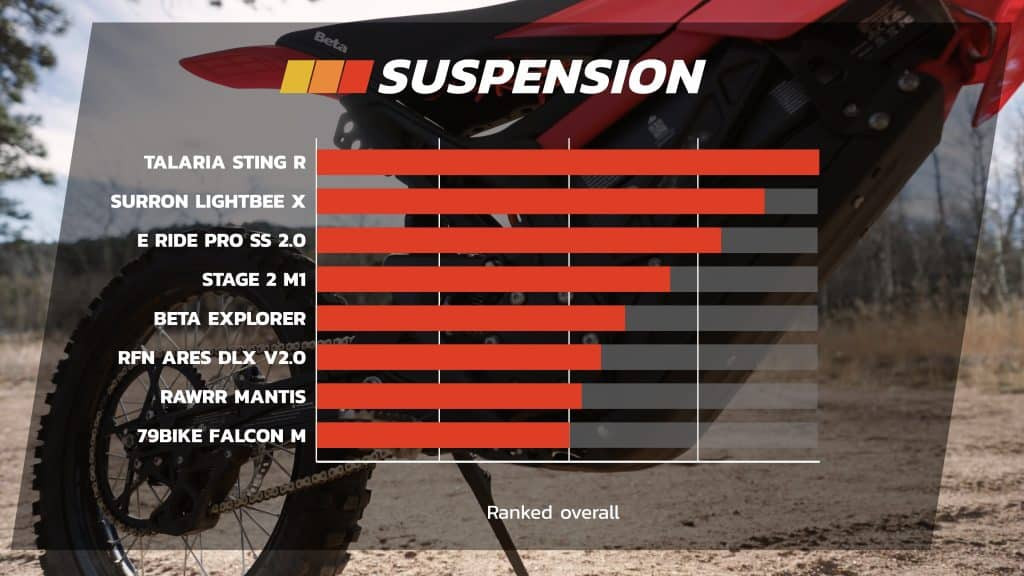 Suspension quality comparison of 2024 electric dirt bikes, with Talaria Sting R and Surron Lightbee X leading in suspension performance.
Suspension quality comparison of 2024 electric dirt bikes, with Talaria Sting R and Surron Lightbee X leading in suspension performance.
Price Point: Affordability Factor
Price is always a crucial consideration. While prices can fluctuate based on dealer and location, based on MSRP, the Stage 2 M1 is the most budget-friendly option at $4,200, while the Beta Explorer is the most expensive at $5,200.
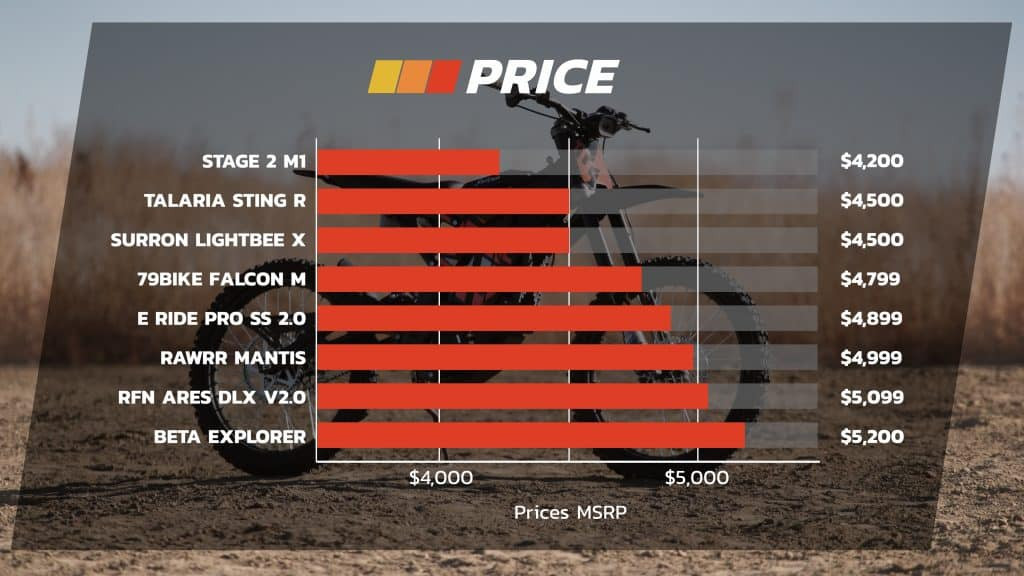 Price comparison of 2024 electric dirt bikes, highlighting Stage 2 M1 as the most affordable and Beta Explorer as the most expensive model.
Price comparison of 2024 electric dirt bikes, highlighting Stage 2 M1 as the most affordable and Beta Explorer as the most expensive model.
Individual Bike Deep Dive: Pros and Cons
Beta Explorer
- Pros: Iconic brand recognition, extensive dealer network for support, aesthetically pleasing bodywork, 18” rear wheel equipped with Kenda tires.
- Cons: Brake sensors are not easily disconnected for maintenance or customization, swingarm exhibits flex, battery removal is complex and time-consuming, low front end geometry, and relatively low power output compared to competitors.
Surron Lightbee X
- Pros: Well-established dealer network providing parts and service, vast aftermarket parts availability for customization, well-suited for dirt jump and BMX style riding, noticeable improvements in suspension compared to earlier models.
- Cons: Underpowered in comparison to newer models, brakes and ergonomics feel somewhat dated, smaller physical size may be less comfortable for larger riders.
Rawrr Mantis
- Pros: Physically larger feel, providing more room for riders, decent initial power delivery, stiff suspension setup.
- Cons: Power output drops off quickly at higher RPMs, brakes are underperforming, step seat design may not suit all riders.
Talaria Sting R
- Pros: Solid and comfortable ergonomics, consistent power delivery throughout the rev range, excellent suspension performance, abundant upgrade options available.
- Cons: Battery rattling within the compartment, small 44-tooth rear sprocket may limit top speed in some conditions.
RFN Ares Rally
- Pros: “Rocket mode” provides a longer duration of boosted power, upgraded tires for improved traction, high-quality foot pegs, swappable headlight/number plate combo for customization, reinforced swingarm for added durability.
- Cons: Low front end can hinder handling in certain terrains, disconnected throttle response, tendency to drag pegs in ruts, lower power output compared to some rivals.
Stage 2 M1
- Pros: Comfortable riding position, good overall ergonomics, solid performing front fork.
- Cons: Slow acceleration and overall speed, poor battery range, unusual handlebar bend, lacks a battery percentage readout, making range management less precise.
E Ride Pro SS
- Pros: Fastest bike in the test, highest top speed, suspension offers good support and “hold-up”, well-equipped with desirable features.
- Cons: Front end can feel twitchy or overly sensitive, large display screen may be vulnerable to damage in crashes.
79Bike Falcon M
- Pros: Fast acceleration, powerful brakes, minimal battery rattling issues.
- Cons: Susceptible to stripped primary belts, clunky linkage noise from the suspension, suspension performance is weaker compared to leading models.
The Verdict: Crowning the Best Lightweight Electric Dirt Bike
After extensive testing and collective evaluation, the E Ride Pro SS Version 2.0 emerged as our unanimous top pick for the best lightweight electric dirt bike under $5,000 in 2024. Its unmatched speed, acceleration, and range, combined with capable suspension and features, made it the clear winner.
The Talaria Sting R secured a very close second place. Its exceptional suspension, comfortable ergonomics, and smooth power delivery are major strengths. Our team agreed that if the Talaria Sting R possessed the raw power of the E Ride Pro SS, it would be the undisputed champion.
The 79Bike Falcon M, Surron Lightbee X, and other models each offer unique strengths and cater to different riding preferences and priorities. Choosing the “best” ultimately depends on individual needs. However, for overall performance and value in the lightweight electric dirt bike category under $5,000, the E Ride Pro SS and Talaria Sting R lead the pack.
Stay tuned to usabikers.net for upcoming content as we explore modifications and upgrades for the Surron Lightbee X and Talaria Sting R, aiming to push their performance even further and potentially close the gap with the E Ride Pro SS.
 The best lightweight electric dirt bike of 2024: E Ride Pro SS Version 2.0, winner of the usabikers.net test and review.
The best lightweight electric dirt bike of 2024: E Ride Pro SS Version 2.0, winner of the usabikers.net test and review.
Final Ranking: Lightweight Electric Dirt Bikes (2024)
- E Ride Pro SS
- Talaria Sting R
- 79Bike Falcon M
- Surron Lightbee X
- Stage 2 M1
- RFN Ares Pro DLX
- Beta Explorer
- Rawrr Mantis

